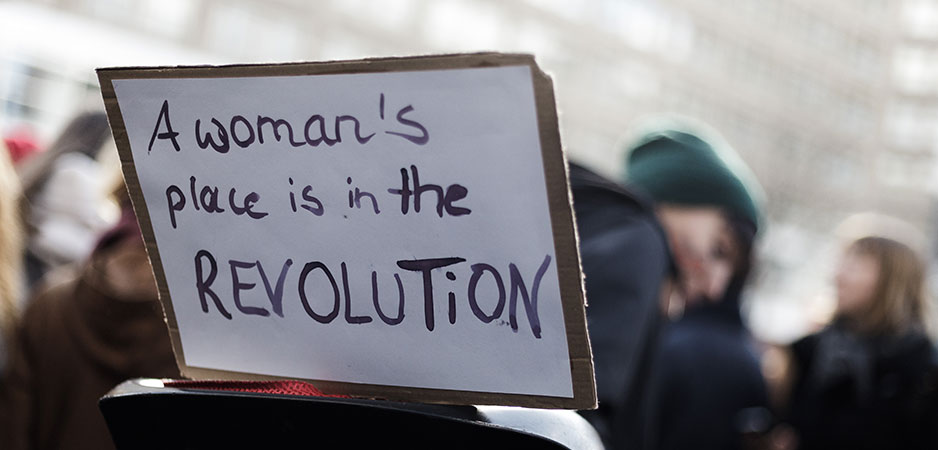In 2006, long before hashtags, Tarana Burke began a grassroots “me too” movement to try and reach women and girl survivors of sexual assault, particularly women of color in low wealth communities. In 2017, actor Alyssa Milano used “me too” as a hashtag, and it went viral. While much has been written and discussed about the #MeToo phenomenon in the United States, where does it fit into the larger scale of women’s movements throughout history? When do women’s movements emerge? Why do women join? What are their impacts?
360° Context: The Me Too Movement — Changing the Rules of the Game
While the major onset of women’s activism is often traced back to the late 1960s and early 1970s, when women in the US and Europe organized around issues of equality in mass numbers, there are numerous examples of women organizing worldwide over the centuries. The movement of women in the 1960s, often referred to as the second wave of feminism — the first being the push for suffrage and other opportunities for women at the turn of the 20th century — is important because it represented a wide-spread, mass-based movement. But it is imperative that we have knowledge and understanding of the larger historical context of women’s activism so we can better understand both what hinders as well as facilitates activism.
Putting the Stereotypes to Work
When and why do women’s movements emerge? Women’s movements emerge for many of the same reasons that any social movement emerges. There are often numerous reasons for people to organize for change, and yet not that many people do. Among the conditions that help enable social movement emergence are: an event that seriously disrupts life, such as an economic depression, a war, an environmental catastrophe; the presence of resources in terms of leaders, money and supplies; a sense of relative deprivation — that your group has less relative to another group that you see as your equal; and the existence of political opportunities that open up a space for your grievance to be heard.
Throughout history, across the globe, these conditions have coalesced at times to help foster movements of women seeking to change their own lives, those of their families and of their communities. For example, in 1929, thousands of women in the provinces of Calabar and Owerri in southeastern Nigeria, organized and led a protest against colonialism, an event which came to be known as the Women’s War. The colonial administrators had imposed a tax on Igbo market women that the women feared would make selling unfeasible, which in turn would disrupt the food supply. The women utilized traditional practices of all-night song and dance, as well non-traditional practices such as attacking European-owned stores and Barclays Bank.
The tax — on top of other colonial injustices — which threatened the food supply, the presence of a women’s network created by the tight bonds these women in the community shared, and the opportunity to utilize traditional protest all help explain this important, early example of feminist and anti-colonial mobilization. So, what makes women’s movements different from other social movements? Can we even talk about a “women’s movement”?
Can we define women’s movements? The answer is both yes and no. There is no worldwide women’s movement, per se. Cultural, religious, ethnic and class differences result in too many varied interests, concerns and needs. Even within countries like the US we cannot speak of a unified women’s movement. There are women on the right side of the political spectrum who organize, as well as women on the left, and they do not often see eye to eye. That said, women’s organizations worldwide do tend to mobilize around issues important to women, and though some may not necessarily challenge broader societal impediments to women’s equality, the issues they mobilize around are focused on women, have female leadership and are organized and developed by women.
Thus, in this way we can think about women’s movements across class, culture, ethnicity and ideology, all in the same breath. Additionally, women’s movements have a few commonalities. Many issues are common across cultures, ethnicities and ideologies, thus prompting women to join movements for similar reasons, such as sexual violence, unequal pay, unequal treatment in the workplace and the home, and more.
Further, women have a tactic at their disposal that is not available to men: The preconceived notions and stereotypes about their sex allow them to do things that men cannot. For example, one afternoon in 1977, during the brutal military dictatorship in Argentina, women organized in the Plaza Del Mayo to protest the mass disappearances of their children, grandchildren and husbands. This group came to be known as the Mothers of the Plaza Del Mayo. The dictatorship was stymied by the women’s actions — it did not feel it could stop them. The women were mourning the loss of members of their family every afternoon for months, years, then decades (the organization is still active today) in the Plaza de Mayo, and the government could do little to end something that was seen as a traditional display of womanhood.
The dictatorship did abduct, and presumably kill, a few of the group’s founders, but it did no more. The junta feared the public backlash that would come from harming women en masse.
This display, undertaken intentionally by women, drew worldwide attention to the issues in Argentina and helped affect change. Women have smuggled bombs and munitions, held “knitting circles” where they plotted and planned protest and were never suspected for a moment because of societal stereotypes about women. These are just a few examples of tactics available to women that are not available to men, and which unite women in their attempts to affect change.
Why Join?
Why do women join women’s movements? While there are many reasons that women, or anyone, for that matter, join a social movement, there are a few key ones that explain most calls to activism. One key reason is that a trauma or disaster has occurred in their life, has “woken” them up. Encouragement from friends, relatives or one’s church can also spur someone to take a step that they may not otherwise take. The removal of barriers to participation — having time, money, free time, etc. — can also enable participation. Feelings of solidarity, of comradery that may come from working together also help motivate someone to join and remain committed. Purposive benefits, that feeling of doing the right thing, also help encourage people to action.
Finally, material benefits matter. If joining can help protect or improve one’s economic well-being, this is a powerful incentive to join, to overcome the fear of stepping forward. While women join social movements for reasons similar to men, often their gendered identities further define what issues mobilize them. And often the main reason for mobilizing as women, especially in the developing world, is because their practical gender needs have been threatened. Thus, historically, movements in the developing world have been focused around interests traditionally associated with women’s realm: health, education, children, access to food and water — practical gender interests.
In South Africa, the group Dzomo La Mupo organized, in part, to protect seeds, soil and indigenous ways of life. The vast majority of farming throughout much of Africa is done by women. Thus, women see first hand the impacts of the destruction of the environment and often organize around interests that have practical impacts on their lives.
On the other hand, women in the advanced industrial world often organize around those interests related to women’s subordination and gender inequities: equal rights, reproductive choice, sexual violence and access to decision-making — strategic gender interests. This helps explain why #MeToo movements in the developing world may struggle at times, as India’s has, for example. Where women’s access to power and resources is narrow, their ability to act on strategic gender interests will be more difficult.
Impact on Society
Women’s movements matter. Just 75 years ago, and sometimes even more recently, women in much of the advanced industrial world, including the United States, Europe and Australia, did not have: equal pay legislation, access to equal credit, no-fault divorce, access to abortion, access to birth control, equal access to higher education, and more. Up until 2015, women in Saudi Arabia were not allowed to vote. Women’s movements have led to the passage of legislation that directly benefits women, not just in the US, but across the globe, from equal pay laws to laws regarding sexual harassment, quotas in legislatures, and more. And while one might argue that legislation doesn’t always have teeth, it is an imperative first step.
Women’s organizing has also led to women’s ministries and bureaus at the national and international level. Public officials cater to women more, actively seeking their vote. Women’s movements have created a cadre of motivated, skilled and politically active women in their wake. Women who can alter the way politics, business, education and more are done. Research has clearly shown the importance of the presence of women in legislatures. Women legislators are more likely to introduce women’s issue legislation (bills about women, children, health, education, the elderly), women’s issue bills are more likely to pass than similar bills introduced by male legislators, women legislators are more likely to work across party lines, are less likely to interrupt witnesses during legislative hearings and are more consensus oriented.
Finally, women’s movements worldwide have had a transformational effect — they have altered how societies view women. Women were once commonly seen as having less intellectual capacity than men, incapable of voting or engaging in politics, seen as physically weaker, easily frightened and in need of the protection of men. While there are certainly still people today who may hold those views, by and large in advanced industrial societies today it is accepted that women have the same intellectual potential as men, do not need to be protected from the “nasty” world of politics, can serve in the military and do not need to be the property of men. While there is clearly room for growth, especially in the developing world, this transformation cannot be ignored.
Where does #MeToo fit in to this larger picture? The #MeToo movement is consistent with the types of movements traditionally seen in the advanced industrial world, organized around strategic gender interests. Women — and men — joined the #MeToo movement because they had experienced a traumatic event, and there were leaders like Tarana Burke, Alyssa Milano and other celebrities who stepped forward and encouraged women to take action. There was a collective sense that something could be done and had to be done, and the political and social environment was ripe.
Women and men were incensed that a president of the United States had blatantly talked about violating women, that powerful men like Harvey Weinstein have been assaulting women unpunished, there was a cadre of educated and trained women who could lead the charge. Enforceable legislation existed, and there were material incentives to join — a chance to change the environment in many industries, an environment that has held women back from access to power, leadership and jobs. The #MeToo movement fits into a rich and deep history of women organizing worldwide, women taking control of their lives, women not waiting for someone else to fix it — women taking charge.
The views expressed in this article are the author’s own and do not necessarily reflect Fair Observer’s editorial policy.
Support Fair Observer
We rely on your support for our independence, diversity and quality.
For more than 10 years, Fair Observer has been free, fair and independent. No billionaire owns us, no advertisers control us. We are a reader-supported nonprofit. Unlike many other publications, we keep our content free for readers regardless of where they live or whether they can afford to pay. We have no paywalls and no ads.
In the post-truth era of fake news, echo chambers and filter bubbles, we publish a plurality of perspectives from around the world. Anyone can publish with us, but everyone goes through a rigorous editorial process. So, you get fact-checked, well-reasoned content instead of noise.
We publish 2,500+ voices from 90+ countries. We also conduct education and training programs
on subjects ranging from digital media and journalism to writing and critical thinking. This
doesn’t come cheap. Servers, editors, trainers and web developers cost
money.
Please consider supporting us on a regular basis as a recurring donor or a
sustaining member.
Will you support FO’s journalism?
We rely on your support for our independence, diversity and quality.

















